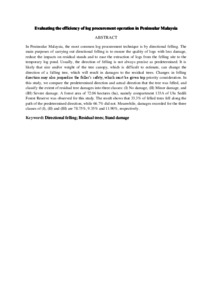Citation
Kamarudin, Norizah and Abdul Malik, Ismail Adnan and A., Lokman and Parman, Rhyma Purnamasayangsukasih and Abdul Rashid, Muhammad Farid
(2017)
Evaluating the efficiency of log procurement operation in Peninsular Malaysia.
The Malaysian Forester, 80 (1).
85 - 98.
ISSN 0302-2935
Abstract
In Peninsular Malaysia, the most common log procurement technique is by directional felling. The main purposes of carrying out directional felling is to ensure the quality of logs with less damage, reduce the impacts on residual stands and to ease the extraction of logs from the felling site to the temporary log pond. Usually, the direction of felling is not always precise as predetermined. It is likely that size and/or weight of the tree canopy, which is difficult to estimate, can change the direction of a falling tree, which will result in damages to the residual trees. Changes in felling direction may also jeopardise the feller’s safety, which must be given top-priority consideration. In this study, we compare the predetermined direction and actual direction that the tree was felled, and classify the extent of residual tree damages into three classes: (I) No damage, (II) Minor damage, and (III) Severe damage. A forest area of 72.06 hectares (ha), namely compartment 133A of Ulu Sedili Forest Reserve was observed for this study. The result shows that 33.3% of felled trees fell along the path of the predetermined direction, while 66.7% did not. Meanwhile, damages recorded for the three classes of (I), (II) and (III) are 78.75%, 9.35% and 11.90%, respectively.
Download File
![[img]](http://psasir.upm.edu.my/61779/1.hassmallThumbnailVersion/Evaluating%20the%20efficiency%20of%20log%20procurement%20operation%20in%20Peninsular%20Malaysia.pdf)  Preview |
|
Text
Evaluating the efficiency of log procurement operation in Peninsular Malaysia.pdf
Download (74kB)
| Preview
|
|
Additional Metadata
Actions (login required)
 |
View Item |

